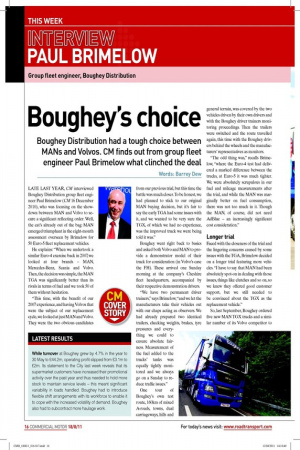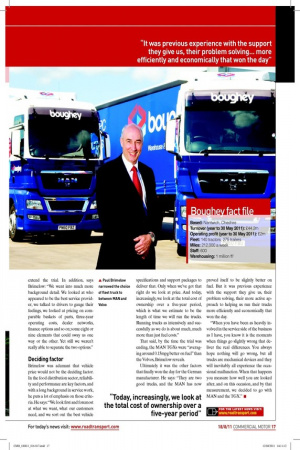Boughey’s choice
Page 14

Page 15

If you've noticed an error in this article please click here to report it so we can fix it.
Boughey Distribution had a tough choice between MANs and Volvos. CM finds out from group fleet engineer Paul Brimelow what clinched the deal
Words: Barrey Dew LATE LAST YEAR, CM interviewed Boughey Distribution group leet engineer Paul Brimelow (CM 16 December 2010), who was focusing on the showdown between MAN and Volvo to secure a signiicant releeting order. Well, the cat’s already out of the bag: MAN emerged triumphant in the eight-month assessment overseen by Brimelow for 50 Euro-5 leet replacement vehicles.
He explains: “When we undertook a similar Euro-4 exercise back in 2007, we looked at four brands – MAN, Mercedes-Benz, Scania and Volvo. Then, the decision was simple, the MAN TGA was signiicantly better than its rivals in terms of fuel and we took 50 of them without hesitation.
“This time, with the beneit of our 2007 experience, and having Volvos that were the subject of our replacement cycle, we looked at just MAN and Volvo. They were the two obvious candidates from our previous trial, but this time the battle was much closer. To be honest, we had planned to stick to our original MAN buying decision, but it’s fair to say the early TGA had some issues with it, and we wanted to be very sure the TGX, of which we had no experience, was the improved truck we were being told it was.” Boughey went right back to basics and asked both Volvo and MAN to provide a demonstrator model of their truck for consideration (in Volvo’s case the FH). These arrived one Sunday morning at the company’s Cheshire leet headquarters, accompanied by their respective demonstration drivers.
“We have two permanent driver trainers,” says Brimelow, “and we let the manufacturers take their vehicles out with our chaps acting as observers. We had already prepared two identical trailers, checking weights, brakes, tyre pressures and everything we could to ensure absolute fairness. Measurement of the fuel added to the trucks’ tanks was equally tightly monitored and we always go on a Sunday to reduce trafic issues.” One tour of Boughey’s own test route, 160km of mixed A-roads, towns, dual carriageways, hills and general terrain, was covered by the two vehicles driven by their own drivers and with the Boughey driver trainers monitoring proceedings. Then the trailers were switched and the route travelled again, this time with the Boughey drivers behind the wheels and the manufacturers’ representatives as monitors.
“The odd thing was,” recalls Brimelow, “where the Euro-4 test had delivered a marked difference between the trucks, at Euro-5 it was much tighter. We were absolutely scrupulous in our fuel and mileage measurements after the trial, and while the MAN was marginally better on fuel consumption, there was not too much in it. Though the MAN, of course, did not need AdBlue – an increasingly signiicant cost consideration.”
Longer trial
Faced with the closeness of the trial and the lingering concerns caused by some issues with the TGA, Brimelow decided on a longer trial featuring more vehicles. “I have to say that MAN had been absolutely spot-on in dealing with those issues, things like clutches and so on, so we knew they offered good customer support, but we still needed to be convinced about the TGX as the replacement vehicle.” So, last September, Boughey ordered ive new MAN TGX trucks and a similar number of its Volvo competitor to extend the trial. In addition, says Brimelow: “We went into much more background detail. We looked at who appeared to be the best service provider, we talked to drivers to gauge their feelings, we looked at pricing on comparable baskets of parts, three-year operating costs, dealer networks, inance options and so on; some eight or nine elements that could sway us one way or the other. Yet still we weren’t really able to separate the two options.”
Deciding factor
Brimelow was adamant that vehicle price would not be the deciding factor. In the food distribution sector, reliability and performance are key factors, and with a long background in service work, he puts a lot of emphasis on those criteria. He says: “We look irst and foremost at what we want, what our customers need, and we sort out the best vehicle speciications and support packages to deliver that. Only when we’ve got that right do we look at price. And today, increasingly, we look at the total cost of ownership over a ive-year period, which is what we estimate to be the length of time we will run the trucks. Running trucks as intensively and successfully as we do is about much, much more than just fuel costs.” That said, by the time the trial was ending, the MAN TGXs were “averaging around 0.15mpg better on fuel” than the Volvos, Brimelow reveals.
Ultimately it was the other factors that inally won the day for the German manufacturer. He says: “They are two good trucks, and the MAN has now proved itself to be slightly better on fuel. But it was previous experience with the support they give us, their problem solving, their more active approach to helping us run their trucks more eficiently and economically that won the day.
“When you have been as heavily involved in the service side of the business as I have, you know it is the moments when things go slightly wrong that deliver the real differences. You always hope nothing will go wrong, but all trucks are mechanical devices and they will inevitably all experience the occasional malfunction. When that happens you measure how well you are looked after, and on this occasion, and by that measurement, we decided to go with MAN and the TGX.” ■

















































